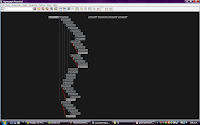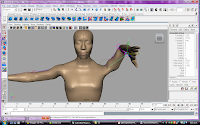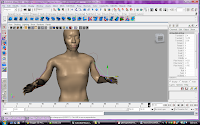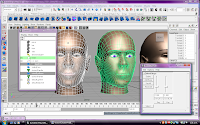These will be uploaded soon.
Thursday, June 24, 2010
Rendering
Rendering involves setting the scenes look and feel by adding colour, textures and lighting.
Unfortunately, I have only looked briefly into these but feel that I have gained a basic understanding of how to set them.
The following is some notes I have gathered on rendering scenes in Maya from the Getting Started with Maya tutorial book.
In Maya, rendering refers to the process of creating bitmap images of your scene
based on the various shading, lighting, and camera attributes that you set.
When rendering, Maya takes into account all of the various objects and scene
attributes, and performs mathematical calculations to produce the final image
or image sequence. Once you render a sequence of images, you can then play
them back in sequence, producing an animation.
Rendering involves many components to produce an image:
■ Shading materials and textures
■ Lighting and shadows
■ Cameras and animation
■ Rendering method
■ Visual effects
Material Description
Lambert: Creates a matte surface without specular
highlights. Lambert is the default shading
material.
Blinn: Creates a shiny surface with specular
highlights, often used to simulate metallic
surfaces.
From the Rendering menu set, select Lighting/shading > Assign New
Material > Lambert or blinn (depending on the effect you want).
Maya renderers
Software rendering can take seconds or minutes to render a single frame of
animation from your scene, depending on the complexity of surface geometry,
shaders, lighting and other visual elements present in the scene.
The following table outlines the different types of renderers in Maya and what
each is used for:
Maya’s Software renderer: A general purpose renderer with broad
capabilities. You can produce high-quality images with complex shading networks, including procedural textures and ramps.
Software rendering is computed through
your machine’s processor.
Interactive Photorealistic Rendering (IPR): A feature of Maya’s software renderer, used
to make interactive adjustments to the final rendered image. You can adjust shading and lighting attributes in real-time, and IPR automatically updates the rendered image to show the effects of your changes.
IPR is useful for tweaking an image before rendering to disk.
mental ray® for Maya® renderer: A general purpose renderer that includes exclusive, advanced rendering functionality, such as host and network parallel rendering,
area light sources for soft shadows, global illumination, and caustics (light patterns).
Maya Vector renderer : A specialized renderer used to produce stylized renderings (for example, cartoon, tonal art, line art, hidden line, wireframe) in various bitmap image formats (IFF, TIFF)
or in 2D vector formats (SWF, AI, EPS, SVG). The Maya Vector renderer is often used to render web-ready images.
Maya’s Hardware renderer: A general purpose renderer that uses your machine’s graphics card for computation. You can produce broadcast resolution images in less time than with software rendering, and in some cases, the quality may be good enough for final delivery.
The Render View window
When you render your scene the rendered image appears in its own window
called the Render View. By default, the Render View uses the same camera as
the Scene View (persp), but includes particular rendering capabilities.
Directional lights
Maya has many types of lights that simulate natural and artificial lighting. A
directional light uses parallel rays of light, as if illuminating from a very far
distance, to illuminate the scene. A directional light is often used to simulate
sunlight.
Spotlights
A spotlight emits light from a single point within a limited cone angle. You can aim a spot light in the direction you want the light to illuminate.
Shadows
Shadows are the darkened areas that appear on a surface when an object gets
in the path of a light source. Shadows are cast onto the area of a surface that
doesn’t directly receive light. Shadows ground the objects in your scene and
aid in defining their three-dimensional appearance. Shadows can add drama
to your scene.
Creating additional cameras in a scene
Elsewhere in this book, you’ve used the default perspective camera to examine
and render your modelling and animation work in progress. In some situations,
it is convenient to create and use additional cameras.
For example, you might want to render the scene from two different camera
views to compare the results. Alternatively, you might want to use the default
camera for interactive modeling and animation and the second camera strictly
for rendering the scene. In the next steps, you create an additional camera
and manipulate its view of the scene.
To create a second camera for the scene
1 Select Create > Cameras > Camera. This creates a perspective camera with
an icon representing it at the center of the grid.
Animating camera moves
In Maya, the camera can be animated. You can set keyframes for the camera
moves the same as for other objects in your scene.
I decided to "batch render" a piece of my animation. The notes stated that this would require a lot of the computers processing power, so I only decided to render the first 50 frames.
Batch rendering a sequence of animation frames
After you model, animate, and color your scene, you set several Render Settings
options and then use the software renderer to batch render part or all of the
animation’s range of frames to files on disk. Each file represents a single frame
(image) of the animation.
After going through the process of setting it up to batch render it states:
Batch rendering 50 frames of a simple scene takes a few minutes. A
complex scene may take hours per frame, depending on the speed of
your computer.
Mine was not that complex but does contain a lot of polygons.. It took 20 minutes for these 50 frames to render and even then, they are not saved as one file, but 50 separate files each of a rendered frame.
Monday, June 7, 2010
Character Setup
In this lesson, you learn the techniques for creating a simple skeleton for a
human character. You will learn how to:
■ Create joints for a character.
■ Name joints in the Hypergraph.
■ Use symmetry when creating a character.
■ Parent joints into an existing skeleton.
■ Use Inverse Kinematics (IK) techniques to pose a skeleton.
Hypergraph Hierarchy: This hierarchy represents the controls of the character skeleton. The top of the hierarchy is the main controller for the character. In this situation it's the lowest point of the back. Other sections are also main controller of their areas such as the arm connections which control the shoulders, elbows and wrists.

Lesson 2: Smooth Skinning.
In this lesson you learn how to:
■ Bind a skeleton using a smooth bind technique.
■ View and modify skin weights using the Skin Weights Tool.
■ Use influence objects to enhance the skin deformation of a character.

At first when the arm is moved it creates un-natural depressions around the shoulder and breast region.

After applying the necessary weights to the area, the arm can be moved around and appear more natural. The above photo shows the arms in similar positions. The right one has been adjusted with the correct weights added where as the left one hasn't. This is most noticeable just under the characters armpit as it has created a large depression.
Lesson 3: Cluster and blend shape deformers.
In this lesson, you will be introduced to cluster deformers in order to shape
a characters mouth into a smile pose. You will learn to use the Blend Shape
feature so you can animate the face from a neutral pose to a smile. In this
lesson, you learn how to:
■ Select CVs in a region and create a cluster deformer.
■ Use the cluster deformer handle to adjust the position of a cluster deformer.
■ Use the Paint Cluster Weights Tool to refine the cluster weight values.
■ Create a Blend Shape deformer to control the blending between target
shapes.
After adding weights around the mouth to make it appear as though the face is smiling.

Subscribe to:
Comments (Atom)
